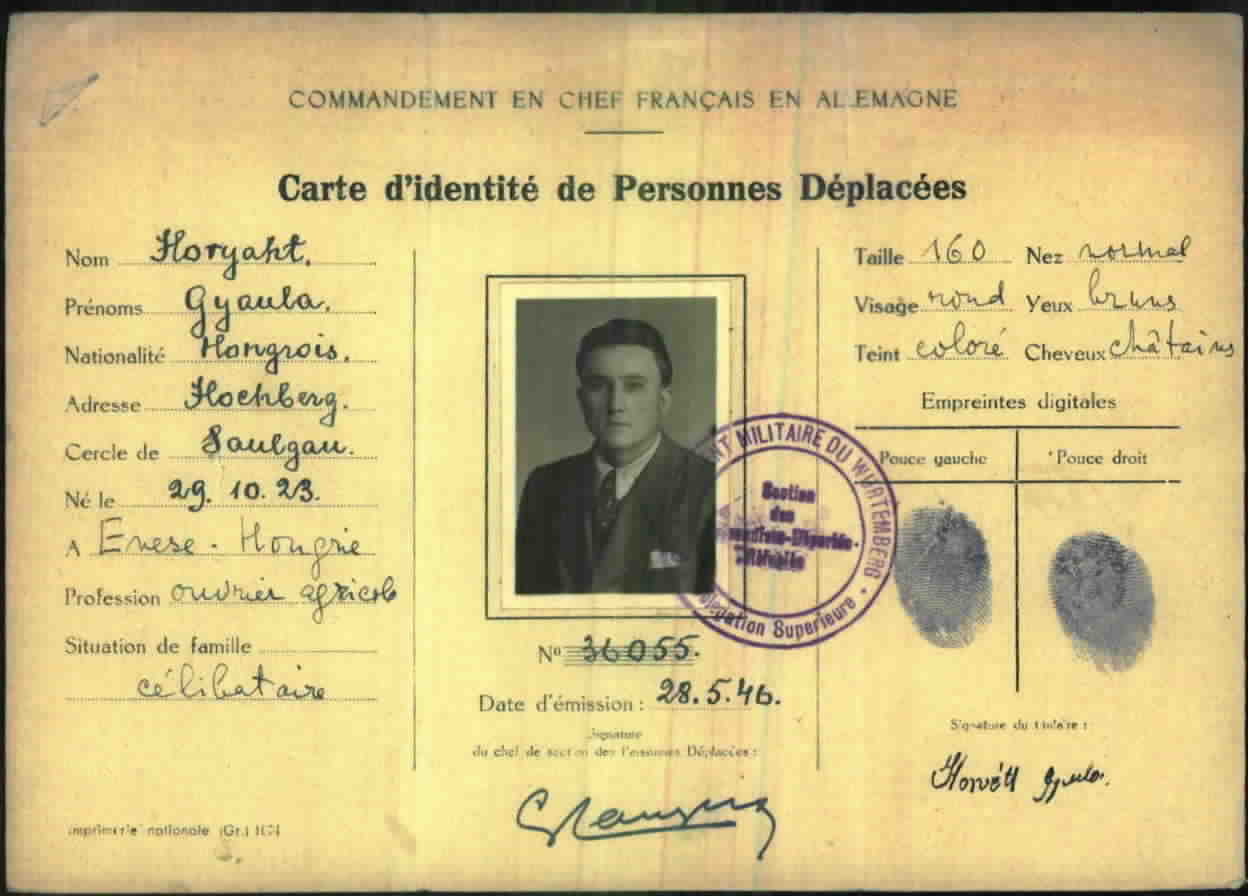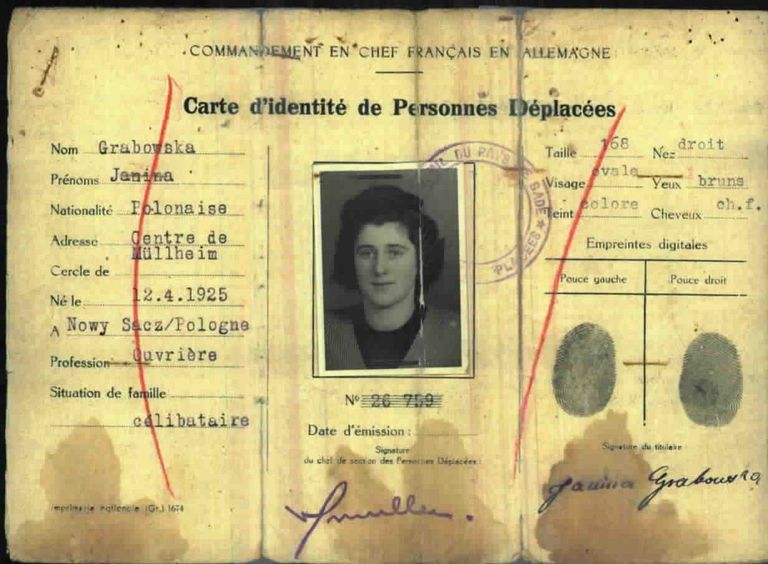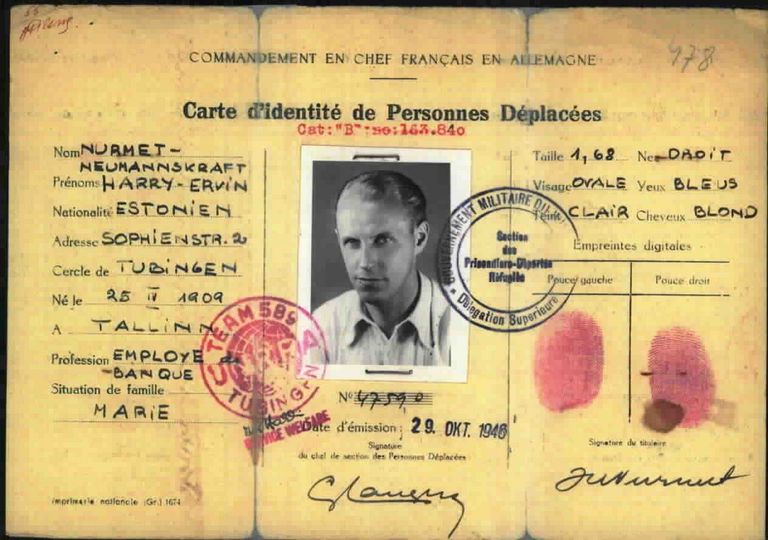Page of
Page/
- Reference
- Intro


As was the case in the other two Western occupation zones, identity cards were issued to DPs in the French zone from 1946 onward. They could use these cards to prove that they were DPs.
Since the military government centrally issued the cartes d’identité de Personnes Déplacées, the cards are largely identical to each other. The only major differences appear in the field for mutations (transfers), where information about the DPs themselves and where they went after the card was issued is described in varying levels of detail. Some of the identity cards are heavily folded and torn, which indicates that the DPs carried these cards with them.
As was the case in the other two Western occupation zones, identity cards were issued to DPs in the French zone from 1946 onward. They could use these cards to prove that they were DPs.
Since the military government centrally issued the cartes d’identité de Personnes Déplacées, the cards are largely identical to each other. The only major differences appear in the field for mutations (transfers), where information about the DPs themselves and where they went after the card was issued is described in varying levels of detail. Some of the identity cards are heavily folded and torn, which indicates that the DPs carried these cards with them.
Questions and answers
-
Where was the document used and who created it?
From 1946, UNRRA and the Ministère des Prisonniers, Déportés et Réfugiés (PDR) – the part of the French government responsible for the DPs – began screening the DPs living in the French occupation zone in Germany. If their information was correct and they fulfilled the criteria for DP status, they were given an identity card by the military government. This was signed by the head of the DP department (chef de direction des Personnes Déplacées) of the military government (Gouvernement Militaire de la Zone française d’occupation en Allemagne). The DPs carried their identity card with them, and information would be added to the cards by UNRRA and later IRO employees, as well as representatives of the French military government.
- When was the document used?
The first DP identity cards were issued in the spring of 1946 – from May at the latest. It is not possible to say exactly how long the cards were used. However, there are some identity cards that were first issued in May 1949. The cards themselves provide information from 1951, for example about a DP’s emigration. This means the identity cards were still being used at this point. By 1954 at the latest, the identity cards were sent to the International Tracing Service (ITS), the predecessor to the Arolsen Archives.
- What was the document used for?
At the end of the war, military units and UNRRA employees did not screen people but instead simply registered everyone who reported to them as a DP. Careful screening would only have delayed their planned repatriation, or the return of millions of people to their countries of origin. From 1946, however, the situation looked different: The DPs who remained behind had to be housed in camps for longer periods of time, and since many of them refused to be repatriated, new arrangements had to be made for them. To ensure that only eligible DPs received assistance, the military governments conducted screenings together with UNRRA.
These screenings took place in all three Western occupation zones. In the French zone, UNRRA and the Ministère des Prisonniers, Déportés et Réfugiés (PDR) set up screening commissions consisting of representatives of UNRRA, the PDR and the DPs themselves. In addition to the commissions in the camps, there were higher-level offices that would handle decisions in cases of doubt. DPs could also appeal a decision. Once their DP status was confirmed, the DPs received a Carte d‘identité de Personnnes Déplacées which they carried with them as proof of their identity as an eligible DP. Employees of UNRRA and the responsible military government could thus see at a glance that they were responsible for supporting the person in question.
Unfortunately, nothing more is known about these identity cards. If you know of any instructions relating to these cards that were issued to the responsible officials, please send an email to eguide@arolsen-archives.org.
- How common is the document?
Based on the research to date, it is at least possible to determine how many DP identity cards must have been issued in the French occupation zone: By the end of 1946, around 36,500 DPs were screened in 58 camps in the French zone. Only 2.8 percent of them – around 1,030 people – were not eligible DPs. Since the rest would have been given a DP identity card, there must have been at least around 35,500 cards.
However, it is not possible to say how many of these cards have been preserved in the Arolsen Archives, because ITS employees sorted the identity cards following an alphabetical-phonetic system and filed them together with other documents in the postwar card file (Nachkriegszeitkartei, Collection 3.1.1.1). This made it easier to search for references to people, but it also means there is no way of knowing how common the DP identity cards are. But in the near future, modern computer technology will find the answer: clustering techniques will make it possible to automatically identify and count the DP identity cards and other types of documents.
- What should be considered when working with the document?
Various DP identity cards were used at different times in the individual occupation zones. In the French zone, the military administration issued the Carte d’identité de Personnes Déplacées. The IRO identity card was the successor to the D.P. identification card previously issued by UNRRA. Both cards were only used in the US occupation zone. In the British zone, PWX/DP Registration/Identity Cards were used. Although the cards were issued by different offices, they all served the same purpose: to identify DPs as DPs.
It is clear that the screenings in 1946 were the starting point for producing the identity cards in the French zone, but more research is needed into the exact procedure and the processes for issuing the cards. For example, it is not clear how exactly the DPs were questioned and what other regulations applied to the identity cards. If you have any information that explains how the identity cards were issued, please send an email to eguide@arolsen-archives.org.
Help for documents
About the scan of this document <br> Markings on scan <br> Questions and answers about the document <br> More sample cards <br> Variants of the document




